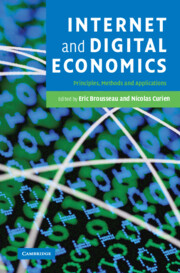Book contents
- Frontmatter
- Contents
- List of figures
- List of tables
- Notes on contributors
- Acknowledgements
- 1 Internet economics, digital economics
- Part I Toward a new economy?
- Part II On-line communities
- Part III Network externalities and market microstructures
- Part IV Producing, distributing and sharing information goods
- Part V How e-markets perform
- Part VI Evolving institutional infrastructures
- 19 An economic analysis of conflicts resolution in cyberspace
- 20 Payment and the Internet: issues and research perspectives in economics of banking
- 21 Electronization of Nasdaq: will market makers survive?
- 22 Multi-level governance of the digital space: does a “second rank” institutional framework exist?
- Part VII The impacts of the Internet at the macro level
- References
- Index
21 - Electronization of Nasdaq: will market makers survive?
from Part VI - Evolving institutional infrastructures
Published online by Cambridge University Press: 22 September 2009
- Frontmatter
- Contents
- List of figures
- List of tables
- Notes on contributors
- Acknowledgements
- 1 Internet economics, digital economics
- Part I Toward a new economy?
- Part II On-line communities
- Part III Network externalities and market microstructures
- Part IV Producing, distributing and sharing information goods
- Part V How e-markets perform
- Part VI Evolving institutional infrastructures
- 19 An economic analysis of conflicts resolution in cyberspace
- 20 Payment and the Internet: issues and research perspectives in economics of banking
- 21 Electronization of Nasdaq: will market makers survive?
- 22 Multi-level governance of the digital space: does a “second rank” institutional framework exist?
- Part VII The impacts of the Internet at the macro level
- References
- Index
Summary
Introduction
During the last decades, stock markets have been witnessing the emergence and the development of new electronic trading systems all around the world. Because the traditional and historical stock market for electronic trading platforms has been Nasdaq, we concentrate on this marketplace. Created in 1971, the National Association of Securities Dealers Automated Quotation system was designed as a dealer market whose purpose was to enhance the efficiency of over-the-counter (OTC) markets. In 30 years, technological innovations that enabled Internet-based trading systems have dramatically changed the structure of the Nasdaq marketplace. Originally designed as financial information networks, new electronic trading systems now bypass the market makers on the stock markets and allow investors to directly compensate and execute their orders with more discretion. They offer the promise of lower trading costs, trader anonymity and faster executions. It is worth stressing that financial networks have always been ahead of most technological changes because efficiency of the system is easy to monetarize.
Electronization of trading has made competition between alternative trading venues greater than before. The rapid growth of electronic trading platforms raises several questions of interest for academics, regulators and investors: is the co-existence of traditional dealers and electronic trading systems sustainable? Will technology drive the convergence towards a pure trading mechanism or can we expect a stable hybrid market architecture?
- Type
- Chapter
- Information
- Internet and Digital EconomicsPrinciples, Methods and Applications, pp. 588 - 616Publisher: Cambridge University PressPrint publication year: 2007
- 1
- Cited by

